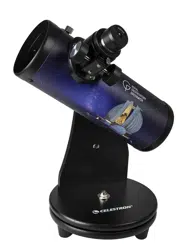Loading ...
Loading ...
Loading ...

ENGLISH | 13
The easiest way to find your way around the sky is using a technique called “starhopping.” To get started, measure the
field of view of your finderscope.
Measuring the Field of View of Your Finderscope.
1. Look in the sky and locate a constellation with bright stars. You can use your planisphere to help identify it. Now find
the map in your star atlas that shows this constellation.
2. Center your finderscope on any bright star that you can recognize on the star map.
3. Hold your head 12 inches behind the reflective window of your StarPointer finderscope and move the telescope so that
the bright star is at the edge of the field if view of the window (it does not matter which direction you pick).
4. Without moving the telescope, look through the finderscope window and locate another star near the opposite edge
of the field of view.
5. Locate this second star on the chart. Measure the distance between these two stars on the chart using a ruler. This
distance is represents one finderscope field of view on your atlas. You can now use this measurement to locate
celestial objects.
Locating Celestial Objects
1. Once you have identified an object you want to find, locate it on your star atlas. Use the map to determine what
constellation it lies in and what bright stars are near it.
2. Now use your planisphere to locate the constellation in the sky and try to locate the bright stars you found
on the star chart near your target. Move your telescope so that the bright star is centered on red dot of your
StarPointer finderscope.
3. Using the scale you just created, find out how many fields of view of the finderscope you need to move and in what
direction to go from the bright star to your target. Looking through the finderscope, move the telescope the same
number of fields of view and in the same direction as indicated by the map. When you are done, your telescope
should be very close to your target.
4. Look through the lowest power eyepiece you have and see if you can see it. If you don’t see it, you can start a systematic
search of the local area. Look through your eyepiece and slowly move the scope back and forth, up and down. Try not
to move more than one field of view of the eyepiece at a time so you don’t miss seeing it. Be sure to move slowly and
take your time. If you still can’t find it, don’t worry. Just go back to your bright star and try it again. With a little patience
and some practice, you will be able to locate these objects without much trouble.
STARHOPPING
Loading ...
Loading ...
Loading ...
